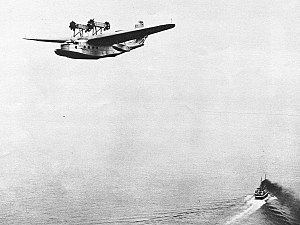The Lioré et Olivier LeO H.242 was a French-manufactured flying boat that was used for European passenger air services in the 1930s. Several were operated by Air France.
One LeO H.242 features at the end of Hergé's The Adventures of Tintin comic King Ottokar's Sceptre.
H-24.01First prototype. Powered by two 373 kW (500 hp) Renault 12Jb engines. One built.
H-241The initial four-engined long-range heavy-weight variant of the H-24. The hull was almost exclusively made of anodised
Duralumin, for corrosion resistance. Although construction began before the H.242, the sole H.241 was completed later, but did not enter production.
H-242Initial production. Powered by four Gnome-Rhône 7Kd Titan Major radial engines. Two were built for Air France and delivered in December 1933 and February 1934. They could carry ten passengers.
H-242/1Revised production version, with a modified engine installation. Twelve were built for Air France and delivered between March 1935 and May 1937, carrying twelve passengers. Most H.242/1s were fitted with wide chord NACA cowlings over the front engine only, but some aircraft were fitted with narrow chord
Townend rings around the front engine.
H-243an un-built projected version for the French navy with enlarged hull.
H-244A projected high-speed inter-continental
flying boat for Air Union, abandoned when Air Union was absorbed by Air France.
FranceAir France ItalyRegia Aeronautica - Captured aircraft.Data from The Encyclopedia of World Aircraft
General characteristics
Crew: 4Capacity: 12 passengersLength: 18.45 m (60 ft 6½ in)Wingspan: 28.00 m (91 ft 10¼ in)Height: 6.33 m (20 ft 9¼ in)Wing area: 116.3 m² (1,251 ft²)Empty weight: 5,868 kg (12,937 lb)Max. takeoff weight: 8,700 kg (19,180 lb)Powerplant: 4 × Gnome-Rhône 7Kd Titan Major 7-cylinder radial engine, 261 kW (350 hp) eachPerformance
Maximum speed: 240 km/h (130 knots, 149 mph)Range: 1,100 km (595 NM, 684 mi)Service ceiling: 4,500 m (14,765 ft)Wing loading: kg/m² (lb/ft²)Power/mass: W/kg (hp/lb) 
